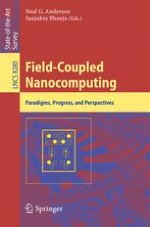2014 | OriginalPaper | Buchkapitel
Reversible Logic Based Design and Test of Field Coupled Nanocomputing Circuits
verfasst von : Himanshu Thapliyal, Nagarajan Ranganathan, Saurabh Kotiyal
Erschienen in: Field-Coupled Nanocomputing
Verlag: Springer Berlin Heidelberg
Aktivieren Sie unsere intelligente Suche, um passende Fachinhalte oder Patente zu finden.
Wählen Sie Textabschnitte aus um mit Künstlicher Intelligenz passenden Patente zu finden. powered by
Markieren Sie Textabschnitte, um KI-gestützt weitere passende Inhalte zu finden. powered by
